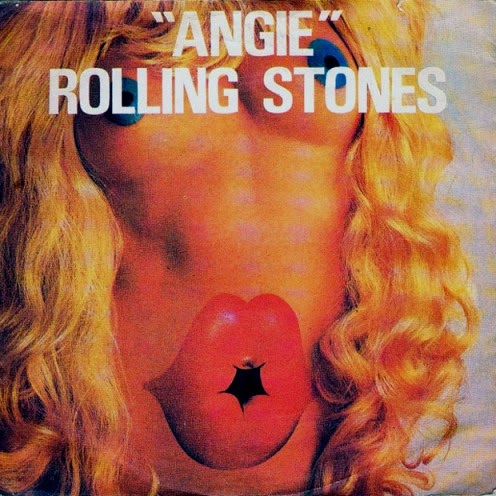The Rolling Stones
"Angie"
Single / B-side: "Silver Train"
Released: 20 August 1973
Album: Goats Head Soup - (Released: 31 August 1973)
Writers: Mick Jagger - Keith Richards
Label: Rolling Stones
"Angie"
Single / B-side: "Silver Train"
Released: 20 August 1973
Album: Goats Head Soup - (Released: 31 August 1973)
Writers: Mick Jagger - Keith Richards
Label: Rolling Stones
"Angie" is a song written by Mick Jagger and Keith Richards and featured on The Rolling Stones 1973 album Goats Head Soup.
 |
| The Rolling Stones' single "Angie", 1973 |
The Rolling Stones - "Angie" (Official Promo Video version 1)
Recorded in November and December 1972, "Angie" is an acoustic-guitar-driven ballad which tells of the end of a romance. The song's distinctive piano accompaniment was played by Nicky Hopkins, a Rolling Stones recording-session regular. The strings on the piece (as well as on another song, "Winter") were arranged by Nicky Harrison. An unusual feature of the original recording is that singer Mick Jagger's vocal guide track (made before the final vocals were performed) is faintly audible throughout the song (an effect sometimes called a "ghost vocal").
Because of the song's length, some radio stations made edits to shorten it to 3 minutes, omitting the longer coda and the second instrumental section of the song.
There was speculation that the song was about David Bowie's first wife Angela, or the actress Angie Dickinson, or Keith Richards' newborn daughter, Dandelion Angela. Richards, who wrote almost all the music and lyrics for the song, claimed in his autobiography that the name Angie was a pseudonym for heroin, and that the song was about his attempt to quit using it while detoxing in Switzerland.
Keith in his 2010 autobiography, Life, wrote: "While I was in the (Vevey drug) clinic (in March-April 1972), Anita was down the road having our daughter, Angela. Once I came out of the usual trauma, I had a guitar with me and I wrote 'Angie' in an afternoon, sitting in bed, because I could finally move my fingers and put them in the right place again, and I didn't feel like I had to s--t the bed or climb the walls or feel manic anymore. I just went, 'Angie, Angie.' It was not about any particular person; it was a name, like ohhh, Diana. I didn't know Angela was going to be called Angela when I wrote 'Angie.' In those days you didn't know what sex the thing was going to be until it popped out."
Mick Jagger achingly sings about a doomed love: "They can't say we never tried / With no loving in our souls and no money in our coats / You can't say we're satisfied," is one of the song's most memorable lines.
(Allmusic review by Bill Janovitz)
The Rolling Stones - "Angie" (Official promo video vers.2)
The Rolling Stones - Angie (Audio HQ)
The Rolling Stones have frequently performed the song in concert; it was included in set lists on their 1973, 1975, and 1976 tours, and they have performed it on every tour since their 1982 European tour. Concert renditions were released on the albums Stripped and Live Licks.
Line-up / Musicians:
Mick Jagger – lead vocals
Keith Richards – guitar, backing vocals
Mick Taylor – guitar, backing vocals
Bill Wyman – bass guitar
Charlie Watts – drums
- With
Nicky Hopkins – piano
Nicky Harrison – string arrangement
Links / Reviews:
Official Website: Goats Head Soup
Wikipedia: Angie (song)
Songfacts: Angie by The Rolling Stones
Allmusic: The Rolling Stones - Angie song review













